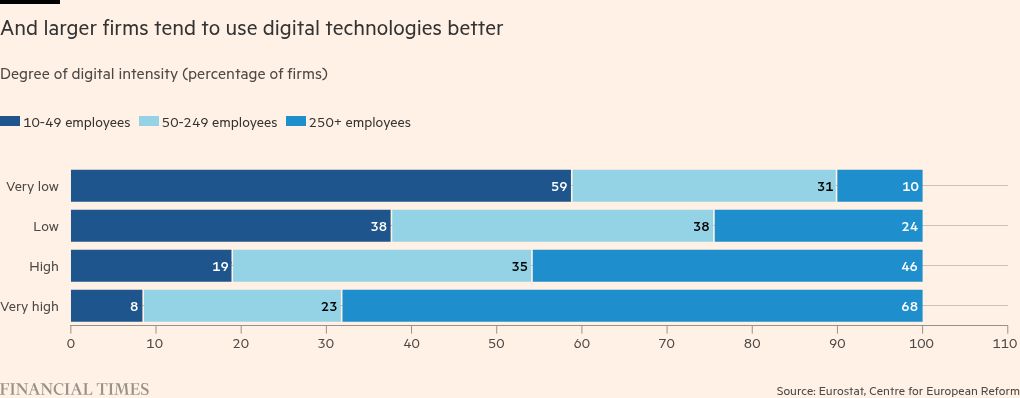Some content could not load. Check your internet connection or browser settings.
However, since the euro’s launch in 1999, Italian governments of all political complexions, including the present rightwing coalition, have generally taken a cautious approach in budgetary matters. They often run primary surpluses — that’s to say, net of debt interest payments — as is expected to be the case next year.
Moreover, Italy’s public debt management agency is skilled at keeping debt repayment schedules under control. A final point is that, when we consider the relatively low levels of indebtedness among non-bank corporations and households, Italy’s overall debt picture looks less alarming.
All the same, there is an Italian problem — chronically low economic growth, and a reluctance among the political classes to grasp the nettle of structural reforms that would raise productivity, competitiveness and the efficiency of public spending.
Underused investment funds
In this assessment for Scope Ratings, a credit-rating agency, Eiko Sievert and Alessandra Poli make a telling point about Italy’s use of EU money, including the multibillion-euro grants and loans available as part of the bloc’s post-pandemic recovery fund:
Under [its recovery fund plan], the country has so far received €113.5bn out of an allocated €194.4bn (around 9 per cent of GDP in 2023), but only about €52bn has been spent to date.
Similarly, out of €129bn in [EU] cohesion funds for 2014-2020 (since extended due to the pandemic), less than a fifth of more than a million projects have been completed to date.
One structural weakness is highlighted in this fascinating report by Emiliano Feresin for Nature Italy. He cites a study by the National Agency for the Evaluation of Universities and Research Institutes, which calculates that Italy had almost 2mn students in 2021, up from 1.7mn in 2011.
It seems a promising trend — except that, in the historically less developed south of Italy, the number of students stood at more than 600,000 in 2011 but has since fallen by about 100,000.
Such imbalances between north and south have preoccupied Italian governments since 1945 — indeed, much earlier — without receiving a convincing solution. Together with the underuse of EU money, they suggest that Italy’s problem is not just where to find the funds for public investment at a time of tight budgets, but how to make sure they are spent well.
EU fiscal rules: the villain of the piece?
The conflicting pressures of fiscal discipline and investment requirements find expression in two landmark EU initiatives this year: the bloc’s painstakingly negotiated new fiscal rules, which came into effect in April, and Mario Draghi’s report on competitiveness, published last month.
Writing for the Omfif think-tank, Taylor Pearce says of Draghi’s report:
The main message is that Europe is in dire need of investment, both public and private . . . A major focus of the Draghi report is Europe’s innovation deficit . . .
The report points to several reasons for this: regulatory constraints, lack of financing mechanisms and a fragmented capital market system that limits growth in innovative sectors.


The question is, how can the EU and its 27 member states heed Draghi’s call to raise investments by €800bn a year, when the new fiscal rules appear to impose severe spending constraints on high-debt countries? A report for the Bruegel think-tank lucidly sets out the problem.
One answer is for the EU itself to borrow more — but that is politically contentious. Another is to define certain types of investment in a more lenient, or more far-sighted, manner.
For example, Poland says the European Commission shouldn’t have included it in its list of miscreant governments with excessive deficits, because higher defence spending — essential on account of the perceived threat from Russia — is the sole reason for the fiscal gap.
Some economists make a broader point. Erik Nielsen, group chief economics adviser for UniCredit Bank, says of the new EU rules:
Surely, it must be wrong to think of debt created for an investment as the same as debt created for consumption. Not only do public investments have different effects on future growth than public consumption or transfers, public investments generate public assets.
Germany’s dubious debt brake
In Germany, the Eurozone’s largest economy, the difficulties stem not from the EU’s new rules but the nation’s old rules — specifically, the “debt brake” that the former government of Angela Merkel inserted into the German constitution in 2009 to limit deficit spending in normal times.
In this trenchant analysis for the Neue Zürcher Zeitung, Eric Gujer explains how the “debt brake” has throttled German public investment so drastically that it now is near the bottom of the EU table for such expenditure.
For sure, Germany suffers from longer-term weaknesses, as the FT’s Guy Chazan reported this week:
Germany is experiencing its first two-year recession since the early 2000s. Falling production in energy-intensive sectors like chemicals and growing competition from China in industries Germany excels in, like cars, are raising questions about the future of its export-led business model.
Still, revising the “debt brake” seems a no-brainer. Unfortunately, I can’t see it happening before next year’s Bundestag elections.
Right now, the opposition Christian Democrats are ahead in opinion polls. If they win, would a CDU-led coalition have the courage or parliamentary votes needed to change the constitution? Perhaps, but it’s not certain.
Eurozone: a half-built house
One final thought. A year ago, Jacques de Larosière, a former IMF managing director, wrote an incisive article for the FT contending that, a quarter of a century after its creation, the Eurozone is still far from a complete fiscal, economic and banking union.
Making progress on that front might contribute to reconciling the conflict between fiscal discipline and the need for much more public investment. But in these politically fractious times, that will be a formidable task in itself.
What policy shifts and new leadership priorities are at play in Europe’s digital economy? Join leaders from Orange Group, Nokia, TIM and more on December 12 at the FT’s Tech Leadership Forum in Brussels and online to discuss how to strengthen connectivity as a competitive economic asset in Europe. Register your free pass here.
Draghi’s wake-up call: will Europe act or snooze? — a commentary by Barry Eichengreen, professor of economics and political science at the University of California, Berkeley, for Social Europe
Tony’s picks of the week
Moldovan voters narrowly approved a referendum proposal to enshrine the country’s EU membership ambitions in the constitution, but hardly anyone supported the idea in the Russian-leaning region of Gagauzia, the FT’s Polina Ivanova reports
US sanctions against Russia have increased Beijing’s concerns about the reliance of Chinese financial institutions on dollars, but China’s interconnectivity with the dollar system is likely to persist in the near term, Robert Greene writes for the Carnegie Endowment for International Peace
Recommended newsletters for you
FT Opinion — Insights and judgments from top commentators. Sign up here
Chris Giles on Central Banks — Vital news and views on what central banks are thinking, inflation, interest rates and money. Sign up here
Source link : http://www.bing.com/news/apiclick.aspx?ref=FexRss&aid=&tid=671ccb1dcab543cb8946f6f0f0d5e312&url=https%3A%2F%2Fwww.ft.com%2Fcontent%2Fc015dc14-068c-40ef-bf57-a2f736f73119&c=13429059833987660174&mkt=de-de
Author :
Publish date : 2024-10-26 02:59:00
Copyright for syndicated content belongs to the linked Source.



